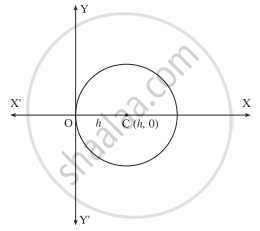Advertisements
Advertisements
प्रश्न
Form the differential equation of all circles which pass through the origin and whose centers lie on X-axis.
उत्तर

Let C(h, 0) be the center of the circle which passes through the origin. Then the radius of the circle is h.
∴ equation of the circle is (x - h)2 + (y - 0)2 = h2
∴ x2 - 2hx + h + y2 = h2
∴ x2 + h2 = 2hx ....(1)
Differentiating both sides w.r.t. x, we get
`"2x" + "2y" "dy"/"dx" = "2h"`
Substituting the value of 2h in equation (1), we get
`"x"^2 + "y"^2 = ("2x" + "2y" "dy"/"dx")"x"`
∴ `"x"^2 + "y"^2 = 2"x"^2 + 2"xy" "dy"/"dx"`
∴ `"2xy" "dy"/"dx" + "x"^2 - "y"^2 = 0`
This is the required D.E.
APPEARS IN
संबंधित प्रश्न
For the differential equation, find the general solution:
`x dy/dx + 2y= x^2 log x`
For the differential equation, find the general solution:
(1 + x2) dy + 2xy dx = cot x dx (x ≠ 0)
For the differential equation, find the general solution:
y dx + (x – y2) dy = 0
For the differential equation given, find a particular solution satisfying the given condition:
`dy/dx - 3ycotx = sin 2x; y = 2` when `x = pi/2`
Find the equation of the curve passing through the origin given that the slope of the tangent to the curve at any point (x, y) is equal to the sum of the coordinates of the point.
Find the equation of a curve passing through the point (0, 2) given that the sum of the coordinates of any point on the curve exceeds the magnitude of the slope of the tangent to the curve at that point by 5.
(x + tan y) dy = sin 2y dx
dx + xdy = e−y sec2 y dy
\[\frac{dy}{dx}\] = y tan x − 2 sin x
Find the general solution of the differential equation \[x\frac{dy}{dx} + 2y = x^2\]
Solve the differential equation \[\left( y + 3 x^2 \right)\frac{dx}{dy} = x\]
Solve the differential equation \[\frac{dy}{dx}\] + y cot x = 2 cos x, given that y = 0 when x = \[\frac{\pi}{2}\] .
Solve the differential equation: (1 +x2 ) dy + 2xy dx = cot x dx
If f(x) = x + 1, find `"d"/"dx"("fof") ("x")`
Solve the following differential equation:
`cos^2 "x" * "dy"/"dx" + "y" = tan "x"`
Solve the following differential equation:
`("x" + 2"y"^3) "dy"/"dx" = "y"`
Solve the following differential equation:
`"dy"/"dx" + "y" * sec "x" = tan "x"`
Solve the following differential equation:
`(1 + "x"^2) "dy"/"dx" + "y" = "e"^(tan^-1 "x")`
`(x + 2y^3 ) dy/dx = y`
Find the general solution of the equation `("d"y)/("d"x) - y` = 2x.
Solution: The equation `("d"y)/("d"x) - y` = 2x
is of the form `("d"y)/("d"x) + "P"y` = Q
where P = `square` and Q = `square`
∴ I.F. = `"e"^(int-"d"x)` = e–x
∴ the solution of the linear differential equation is
ye–x = `int 2x*"e"^-x "d"x + "c"`
∴ ye–x = `2int x*"e"^-x "d"x + "c"`
= `2{x int"e"^-x "d"x - int square "d"x* "d"/("d"x) square"d"x} + "c"`
= `2{x ("e"^-x)/(-1) - int ("e"^-x)/(-1)*1"d"x} + "c"`
∴ ye–x = `-2x*"e"^-x + 2int"e"^-x "d"x + "c"`
∴ e–xy = `-2x*"e"^-x+ 2 square + "c"`
∴ `y + square + square` = cex is the required general solution of the given differential equation
The integrating factor of the differential equation sin y `("dy"/"dx")` = cos y(1 - x cos y) is ______.
The slope of the tangent to the curves x = 4t3 + 5, y = t2 - 3 at t = 1 is ______
Integrating factor of `dy/dx + y = x^2 + 5` is ______
Which of the following is a second order differential equation?
The equation x2 + yx2 + x + y = 0 represents
Let y = y(x), x > 1, be the solution of the differential equation `(x - 1)(dy)/(dx) + 2xy = 1/(x - 1)`, with y(2) = `(1 + e^4)/(2e^4)`. If y(3) = `(e^α + 1)/(βe^α)`, then the value of α + β is equal to ______.
Let y = y(x) be a solution curve of the differential equation (y + 1)tan2xdx + tanxdy + ydx = 0, `x∈(0, π/2)`. If `lim_(x→0^+)` xy(x) = 1, then the value of `y(π/2)` is ______.
Let y = f(x) be a real-valued differentiable function on R (the set of all real numbers) such that f(1) = 1. If f(x) satisfies xf'(x) = x2 + f(x) – 2, then the area bounded by f(x) with x-axis between ordinates x = 0 and x = 3 is equal to ______.
If the solution curve y = y(x) of the differential equation y2dx + (x2 – xy + y2)dy = 0, which passes through the point (1, 1) and intersects the line y = `sqrt(3) x` at the point `(α, sqrt(3) α)`, then value of `log_e (sqrt(3)α)` is equal to ______.
